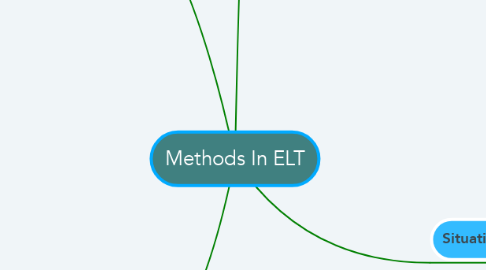
1. Direct Method
1.1. Reformist Era
1.1.1. 1920s
1.2. Objectives
1.2.1. Long term: Efficient oral skills
1.3. Approach
1.3.1. This method doesn't have approach.
1.3.2. Souveur(Europe)
1.3.3. Berlitz(America)
1.4. Distinctive Features:
1.4.1. Teachers were native speakers.
1.4.2. Primarily employed in private schools.
1.4.3. Applied naturalistic language acquisition principle.
2. Audiolingual Method
2.1. Objectives
2.1.1. Long Term: Nativelike proficiency
2.1.2. Short term: including listening comprehension, accurate pronunciation and oral production
2.2. Approach
2.2.1. Structuralism
2.2.1.1. L. Bloomfield
2.2.1.1.1. ''Language is speech.''
2.2.1.1.2. ''Language is what a native speaker says.''
2.2.1.1.3. ''Languages are different, there might be varieties(mentioning differences in L1 and L2).''
2.2.1.2. Saussure
2.2.1.2.1. ''Main linguistic units are system of signs.''
2.2.1.2.2. ''The subject method of linguistics is not parole but langue.''
2.2.2. Behaviorism
2.2.2.1. Skinner
2.2.2.1.1. ''Language is a mechanical process of habit formation.''
2.2.2.1.2. ''Language skills are learned more effectively if learned in spoken form.''
2.3. Distinctive Features
2.3.1. It is the first method with an approach.
2.3.2. Effects of this methods are very observable today.
2.4. 1950s
3. Grammar Translation Method
3.1. Classical Era
3.1.1. Between 17th-19th centuries
3.2. Objectives
3.2.1. Long term:Ability to translate and to read& understand literary or philosophical texts.
3.2.2. Short term: Understanding grammar and vocabulary.
3.3. Approach
3.3.1. This method does not have approach.
3.4. Distinctive Features
3.4.1. Classes are in mother tongue.
3.4.2. Vocabulary is taught as set of isolated words.
3.4.3. Listening, speaking and pronunciation accuracy are not a concern.
4. Situational Language Teaching
4.1. Base: 1930s and 60s Effects: Still in use
4.2. Objectives
4.2.1. Long term: Nativelike proficiency in all skills
4.2.2. Short term: A practical command in all skills, structurally.
4.3. Approach
4.3.1. British Structuralism
4.3.1.1. H. Palmer
4.3.1.1.1. Spontaneous Capacities vs Studial Capacities
4.3.1.1.2. Palmer's Eight Principles
4.3.1.2. Hornby
4.3.1.2.1. ''The best way to teach what to teach firstly should be what can be embedded in classroom.''
4.3.2. American Behaviorism
4.3.2.1. Palmer
4.3.2.1.1. ''Habit formation is combination of processes rather than conditions.''
4.4. Distinctive Features
4.4.1. Concreteness: Teaching should be done from concrete to abstract
4.4.2. Gradation: In an ideally graded course, students should receive relatively small but expressively functional knowledge.
4.4.3. Use of substitution tables
